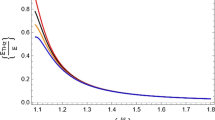Abstract
The results of quantitative evaluation of the heat accumulation effect during the femtosecond laser microstructuring of the surface of silicon are presented for discussion. In the calculations, the numerical–analytical method is used, in which the dynamics of electronic processes and lattice heating are simulated by the numerical method, and the cooling stage is described on the basis of an analytical solution. The effect of multipulse irradiation on the surface temperature is studied: in the electronic subsystem, as the dependence of the absorbance on the excited carrier density and the dependence of the absorbance on the electron-gas temperature; in the lattice subsystem, as the variation in the absorbance from pulse to pulse. It was shown that, in the low-frequency pulse-repetition mode characteristic of the femtosecond microstructuring of silicon, the heat accumulation effect is controlled not by the residual surface temperature by the time of the next pulse arrival, which corresponds to conventional concepts, but by an increase in the maximum temperature from pulse to pulse, from which cooling begins. The accumulation of the residual temperature of the surface can affect the microstructuring process during irradiation near the evaporation threshold or with increasing pulse-repetition rate.
Similar content being viewed by others
References
L. Cerami, E. Mazur, S. Nolte, and C. B. Schaffer, in Ultrafast Nonlinear Optics, Ed. by R. Thomson, Ch. Leburn, and D. Reid, Scottish Graduate Series (Springer International, Switzerland, 2013), Vol. 13, p. 287.
B. Wu, M. Zhou, J. Li, X. Ye, G. Li, and L. Cai, Appl. Surf. Sci. 256, 61 (2009).
M. Barberoglou, G. D. Tsibidis, D. Gray, E. Magoulakis, C. Fotakis, E. Stratakis, and P. A. Loukakos, Appl. Phys. A 113, 273 (2013).
J. Bonse, S. Baudach, J. Krüger, W. Kautek, and M. Lenzner, Appl. Phys. A 74, 19 (2002).
W. Han, L. Jiang, X. Li, P. Liu, L. Xu, and Y. F. Lu, Opt. Express 21, 15506 (2013).
F. Garrelie, J. P. Colombier, F. Pigeon, S. Tonchev, N. Faure, and M. Bounhalli, Opt. Express 19, 9035 (2011).
P. T. Mannion, J. Magee, E. Coyne, G. M. O’Connor, and T. J. Glynn, Appl. Surf. Sci. 233, 275 (2004).
A. Y. Vorobyev and C. Guo, Appl. Phys. Lett. 86, 011916 (2005).
S. M. Eaton, H. Zhang, P. R. Herman, F. Yoshino, L. Shah, J. Bovatsek, and A. Y. Arai, Opt. Express 13, 4708 (2005).
G. A. Martsinovskiy, G. D. Shandybina, Yu. S. Dement’eva, R. V. Dyukin, S. V. Zabotnov, L. A. Golovan’, and P. K. Kashkarov, Semiconductors 43, 1298 (2009).
R. V. Dyukin, G. A. Martsinovskiy, G. D. Shandybina, E. B. Yakovlev, and I. V. Guk, J. Opt. Technol. 78, 558 (2011).
R. V. Dyukin, G. A. Martsinovskiy, O. N. Sergaeva, G. D. Shandybina, V. V. Svirina, and E. B. Yakovlev, in Laser Pulses—Theory, Technology, and Applications (Rijeka, InTech, 2012), Vol. 7, p. 197.
I. A. Ostapenko, S. V. Zabotnov, G. D. Shandybina, L. A. Golovan’, A. V. Chervyakov, Yu. V. Ryabchikov, V. V. Yakovlev, V. Yu. Timoshenko, and P. K. Kashkarov, Izv. Akad. Nauk, Ser. Fiz. 70 (9), 1315 (2006).
Y. Han and S. Qu, Chem. Phys. Lett. 495, 241 (2010).
E. B. Yakovlev, O. N. Sergaeva, V. V. Svirina, and M. V. Yarchuk, Proc. SPIE 9065, 906509 (2013).
I. V. Guk, G. A. Martsinovskiy, G. D. Shandybina, and E. B. Yakovlev, Semiconductors 47, 1616 (2013).
S. V. Zabotnov, I. A. Ostapenko, L. A. Golovan’, V. Yu. Timoshenko, P. K. Kashkarov, and G. D. Shandybina, Quantum Electron. 35, 943 (2005).
A. Y. Vorobyev and C. Guo, Opt. Express 19, 1032 (2011).
Y. Yang, J. Yang, L. Xue, and Y. Guo, Appl. Phys. Lett. 97, 141101 (2010).
A. A. Vedenov and G. G. Gladush, Physical Processes in Laser Material Processing (Energoatomizdat, Moscow, 1985) [in Russian].
O. Varlamova, M. Bounhallia, and J. Reif, Appl. Surf. Sci. 278, 62 (2013).
Y. Ma, J. Si, X. Sun, T. Chen, and X. Hou, Appl. Surf. Sci. 313, 905 (2014).
Author information
Authors and Affiliations
Corresponding author
Additional information
Original Russian Text © I.V. Guk, G.D. Shandybina, E.B. Yakovlev, 2016, published in Fizika i Tekhnika Poluprovodnikov, 2016, Vol. 50, No. 5, pp. 706–710.
Rights and permissions
About this article
Cite this article
Guk, I.V., Shandybina, G.D. & Yakovlev, E.B. Role of the heat accumulation effect in the multipulse modes of the femtosecond laser microstructuring of silicon. Semiconductors 50, 694–698 (2016). https://doi.org/10.1134/S1063782616050080
Received:
Accepted:
Published:
Issue Date:
DOI: https://doi.org/10.1134/S1063782616050080




